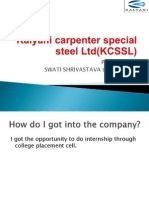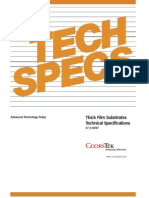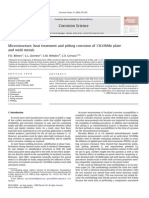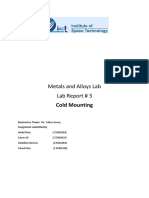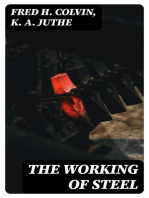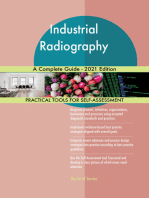Distortion Reduction in Gear by Simple Heat Treatment Process by Simple Fixture
Distortion Reduction in Gear by Simple Heat Treatment Process by Simple Fixture
Uploaded by
VireshVermaCopyright:
Available Formats
Distortion Reduction in Gear by Simple Heat Treatment Process by Simple Fixture
Distortion Reduction in Gear by Simple Heat Treatment Process by Simple Fixture
Uploaded by
VireshVermaOriginal Description:
Copyright
Available Formats
Share this document
Did you find this document useful?
Is this content inappropriate?
Copyright:
Available Formats
Distortion Reduction in Gear by Simple Heat Treatment Process by Simple Fixture
Distortion Reduction in Gear by Simple Heat Treatment Process by Simple Fixture
Uploaded by
VireshVermaCopyright:
Available Formats
International Journal of Emerging Technology and Advanced Engineering
Website: www.ijetae.com (ISSN 2250-2459, ISO 9001:2008 Certified Journal, Volume 4, Issue 11, November 2014)
Distortion Reduction in Gear Heat Treatment Process by a
Simple Fixture
Jeevan P. George1, Justin Koshy2, Biju cherian Abraham3
1
PG Scholar, Assistant Professor, 3Associate Professor, Department of Mechanical Engineering, Mar Athanasius College
of Engineering, Kothamangalam, Kerala, India
At the time heat treating the part there will be large
deformation during carburizing and quenching processes
[7]. The study on the part of cooler fan drive gear is made
up of ZFNL 9201 material and its chemical compositions
are C (0.15-0.19), Mn (0.4-0.6), Cr (1.4-1.7), Si (max.
0.35) P (max. 0.015), S (0.015), Ni (1.4-1.7), Mo (max
0.1), Cu (max 0.2), Al (max 0.045).
Mechanical properties of material ZFNL9201 are,
Abstract Cooler fan drive gears are used in the MGB
for cooler fan to cooling the oil in the ALH Helicopters. The
manufacturing of the cooler fan drive gear involves CNC
turning, milling, heat treatment and grinding operations
etc. The cooler fan drive gear of the ALH helicopter was
facing critical problem of rejection when it is heat treating.
At the time of quenching the gear is getting distorted due to
stresses acting on to the part. In order to reduce the
distortion which has occurred during the quenching
something need to be done to optimize the process during
that time. So by the implementation of the fixture at time of
heat treatment and tested it in a batch to saw that distortion
could be reduced.
Yield strength
: 750 N/mm2
Tensile strength
: 1100-1500 N/mm2
Elongation
: >=7 %
Reduction
: >=30%
Charpy work Impact
: >=20 J
Use of the fixture can be reducing the distortion in the
cooler fan drive gear [1]. The reason may be the
inadequate support provided for the gear during heat
treatment. Therefore to provide adequate or better
support to gear to avoid sagging during heat treatment.
Keywordsheat treatment Process, Gear, Distortion
I. INTRODUCTION
Heat treatment is used to improve some of the
mechanical properties of steel components and
commonly involves a quenching step which may cause
undesired geometric distortions in the processed parts.
The dimensional accuracy of these parts is affected and
leads to production and economical losses.
An example of this situation is the production of rolled
and heat treated rings with large diameters and small
thickness, where quenching causes out-of-roundness of
rings. Various factors including phase transformation of
steel, retained austenite, quench media, severity and
uniformity and process selection may influence the final
dimension of a quenched part [6].
The plastic deformation of metallic components during
heat treatment is referred to as distortion. Distortion
occurs if the stress in the material exceeds the yield stress
of the material. During case hardening the components
are exposed to high temperatures in the range of 880 oC to
1050oC and the yield stress decreases strongly with
increasing temperature of a component. Three different
types of stress in the material need to be distinguished.
1. Residual stresses are induced before heat treatment
by casting, forging, machining etc..
2. Thermal stresses are caused by the temperature
gradient while heating and quenching.
3. Transformation stresses are caused by the
transformation from ferrite to austenite during
heating and transformation from austenite to
martensite or bainite during quenching.
II. LITERATURE REVIEW
From the literature of Identification of gear Gear
distortion in manufacturing and finding solution using
Reactive improvement Methodology [1].This journal is
describe about the distortion of gear during heat
treatment there by gears are unusually given an extra
machining allowance which is leading to increased
machining cost. In this work using improvement reactive
methodology, efforts are made to understand the problem
of gear distortion and find the remedial measures. This
paper presents the three way of how to resolve the
distortion during heat treatment. (i) Use of improved
fixture to hold the gear during the heat treatment, (ii)
better cooling mechanism, and (iii) reduction of gear
weight by making design modification. In the Evaluation
of process causes and influences of residual stress on
gear distortion [2], the paper dealt about the idea is
developed through simulation and experiments including
annealing to understand the impact of residual stress on
gear distortion. Low Distortion Heat Treatment of
Transmission Components [3], this paper presents how
low pressure carburizing and high pressure gas
quenching processes are successfully applied on internal
ring gears for a 6 speed automatic transmission to reduce
the distortion. This paper is mentioning the fixturing is
another factor for distortion control.
306
International Journal of Emerging Technology and Advanced Engineering
Website: www.ijetae.com (ISSN 2250-2459, ISO 9001:2008 Certified Journal, Volume 4, Issue 11, November 2014)
Defects and Distortion in Heat-Treated Parts [4] is a
hand book, tells about shape distortion or warpage. This
is sometimes called straightness or angularity change. It
is found particularly in nonsymmetrical components
during heat treatment. From the practical viewpoints,
warpage in water- or oil-hardening steels is normally of
greater magnitude than is size distortion and is more of a
problem because it is usually not predictable.
Development, Fabrication and Analysis of Fixture [5],
this paper deals with the how a fixture is effectively
fabricate and its analysis.
III. PROBLEM DEFINITION AND ANALYSIS
The cooler fan drive gear is facing the distortion
during the heat treatment process. Often the distortion
has arise at carburizing and quenching. Both the
processes have not been able to meet the specifications
because of the improper seating. The cooler fan drive
gear is small in size so the number of parts undergoing
the process will be high, therefore the batch of operation
can be performed. Because of the number of parts in a
batch is high, it is very hard to do the heating process in
carburizing as well as quenching due to the excess of
parts, therefore could not meet the specifications as
required.
Figure 1: General fish bone diagram
Due to specifications have not been able to meet at
random side of the component it would generate
contraction and expansion. By the generation of the
contraction and expansion the concentric centre of the
circle would differ from its diameter, hence runout
generated. After it has completed the heat treatment,
comes over the grinding operation. At the time of
grinding operation only this defect is formed like as
warpage, ovality and unground portions. So due to the
formation of these defects it cannot be forwarded for the
further operation. This is because distortion of the part
during heat treatment. Hence the efforts are made to
understand the problem of distortion and find the
remedial measures.
In the lead and profile problem has generated due to
the grinding wheel. Due to the improper positioning of
the grinding wheel this problem had been generated.
The profile mill is the problem has occurred to the four
legs of the component which has due to by the milling
operation. It has been resolved by the proper milling
operation.
The runout is the main problem arises for the cooler
fan drive gear after the improper quenching. So the
efforts are made to prevent the runout during quenching.
The residual stresses are the main reason for the runout
formation. The residual stresses can be created in the
part. The stresses will be relieved during heat treatment,
resulting in component distortion. To minimize the
formation of residual stresses, it is often necessary to turn
the part over several times during the machining
operation. It is also often necessary to include several
stress relief operations during the machining operations.
The amount of residual stresses created in a shop is
highly dependent on its various practices. This includes
tool sharpening frequency, feeds and speeds, quenching,
etc
A. General Fishbone Diagram for Distortion
To identify the root causes, the cause and effect
diagram has been drawn to find the causes which affect
on distortion of the gear. Causes can be derived from
brainstorming sessions. These groups can then be labeled
as categories of the fishbone. It has find out that different
main causes are affecting the gear during the machining
operation as well as heat treatment. For this part so far
been affected three main problems are runout, profile
mill and lead and profile.
307
International Journal of Emerging Technology and Advanced Engineering
Website: www.ijetae.com (ISSN 2250-2459, ISO 9001:2008 Certified Journal, Volume 4, Issue 11, November 2014)
B. Data Collection
The data given below are the previous batch problems.
The data given in the tables are the rejection, acceptation
of the part and reason for the rejection of the part as well.
For example, many processes prior to heat treatment
involve material removal such as grinding, broaching,
and turning, quenching, carburizing. These operations
create a large amount of residual stresses in the part,
which are relieved during heat treatment, resulting in part
distortion.
TABLE I
DATA COLLECTION
Work order
no.
No. of parts
Accepted
produced
Rejected
Reason
for
rejection
7512100989
Lead and
profile
quality
measuring
more
7607101792
16
10
Runout
7507101248
Runout
7512029880
10
Profile
mill
Figure 2: Fish bone diagram
The data collection of the cooler fan drive has been
taken for previous batches. Out of 35 parts produced, in
that 17 got rejected due to various reasons. In the first
work order there are 4 parts produced, 3 got rejected due
to lead and profile run out measurement is more. Next
work order has 16 parts produced, in that 6 got rejected
due to run out. Another work order has 5 parts produced,
in that 2 got rejected due to run out. Next work order has
10 parts produced, in that 6 parts got rejected due to
profile milling operation.
D. Pie Chart
The pie chart has been drawn to classify the reasons
and analyze it to execute reason which has most affect
the rejection of the gear.
C. Fishbone Diagram for Distortion
The root causes of the distortion for the components
are drawn in this fishbone diagram. So far the part been
got distorted due to the improper quenching and
improper machining. Improper positioning of fixture in
the both carburizing as well as quenching were leads to
residual stresses are formed on the random side of the
component there by improper heating processes causes to
get distorted.
Distortion of parts after heat treating is the greatest
source of problems for heat treaters distorted parts can
lead to potentially early failure due to high residual
stresses. Figure 3.2 shows that many sources of residual
stress and distortion occur before and during heat
treatment.
Figure 3: Pie Chart
After the pie chart has been drawn it is very easy to
understand how much the rejection rate of the part is
following the distortion. 47% is due to runout, 35% due
to profile mill and 18% due to lead profile as well. From
the given pie chart it is understand that the largest
percentage of rejection rate is due to run out. To
eliminate the run out in the part it is must be prevent the
distortion during the heat treatment.
308
International Journal of Emerging Technology and Advanced Engineering
Website: www.ijetae.com (ISSN 2250-2459, ISO 9001:2008 Certified Journal, Volume 4, Issue 11, November 2014)
E. Gear Geometry and Measurement Report
According to the geometry, the gear has been
manufactured. The measurement report of the gear has
been tabulated regarding with the critical dimensions of
the part. The readings given in the measurement report
are the measurement of the part of critical dimensions,
surface finish and hardness values.
This report is furnished after the quenching. In that the
runout portion of the gear has varied from its within the
limit. So the part has been rejected. Other measurements
of the part were within the limit of its dimension. The
table given below has shown the measurement of the
eight parts.
TABLE 2
RUN OUT MEASUREMENT REPORT
Quenching selection- the quenched used here is the
meta- quench oil (SAE 39) especially for the
aerospace applications.
The table 3.3 has provided runout dimensions of the
part. After the checking of the measurement report. The
dimensions of the runout are out of limit. So the
particular run out reading has been drawn out in the table.
Quenching time- the quenching time taken for the
component can be vary. But it is unable to obtain
the same hardness which required for it.
F. Rectification of Distortion during Quench Hardening
There are some solutions to rectify the distortion
problem during heat treatment are given below.
Proper fixturing- the fixture is used to support the
gear during heat treatment process. Therefore to
provide adequate support to gear to avoid any kind
of distortion during the heat treatment process
Component design modification- the design of the
component is already fixed. Further there is nothing
can be changed.
309
International Journal of Emerging Technology and Advanced Engineering
Website: www.ijetae.com (ISSN 2250-2459, ISO 9001:2008 Certified Journal, Volume 4, Issue 11, November 2014)
Without any major amendment to the present
treatment like changing the quenchent, changing the
material etc. which all are leads to economical changes.
A proper fixturing is more suitable to reduce the
distortion in the component
Step 2
Geometrical model of the component: is done by
the critical dimension
Step 3
Selection of tooling material: the material used in
the fixture may be varies regarding its application
IV. RESULT AND DISCUSSION
A. Fixture
The reason for the distortion is the inadequate support
provided for the gear during heat treatment. So aim is to
provide better or adequate support to gear to avoid
sagging during the heat treatment process. After found
out the problem, its importance in the suggestion of the
fixture and its complete fabrication has comes to evolve
at end. When its need at the time of heat treatment is not
complex so made of the fixture was easy as well. The
fixture has arrest the stresses happened at the time of
quenching thereby can reduce the rejection rate. Some
important requirements taken into account when
designing the fixture were, The material used for the
fixture is medium carbon steel(C-45). The material is
used in the fixture is harder than the material used in the
part. So the stresses act during the time of quenching can
be prevented up to a limit. The properties of the material
used in the fixture are,
Step 4
Solid modelling of tool: 3D modelling of the entire
component is done by using unigraphics software
Study of the component has been carried first to
understand the material and its property to finalize the
design of the fixture. The size and weight are important
parameters for considering the design of the fixture. The
clamp area, critical measurements are important area of
concern. Next step is to understand the geometrical
model of the component it is done by the critical
dimensions of the component.
In the next step, it is important consider the tooling
material or fixture material .this step is most important
for design of the fixture, why because the fixture need is
in heat treatment. Here the fixture is covered the
component in order to prevent the contraction as well as
to support the component in the steady position as well.
So this step is most important for the designing of the
fixture.
Here, the number of fixture need in this heat treatment
is two. One of the fixture is need at the time of
carburizing operation. It is need to put a dead weight on
the component to avert the movement from the vertical
position. Other quenching to prevent direct contact of the
quenchent to affect the component. Next step is the
designing software, after understand the basic
requirement for the fixture for designing, unigraphics
selected for the designing the fixture.
Medium Carbon Steel (C-45)
C
0.4-0.5
Si
0.1-0.35
Mn -
0.6-0.9
Two separate blocks are fabricated ALH31679(Carburizing) and ALH-31680 (Quenching), one is
support the part for carrying out carburizing and other is
to load the part for carrying out quenching as well. For
the quenching block outer diameter of the component is
taken into consideration. For the carburizing the inner
diameter of the component is taken into consideration
C. Fixture for Carburizing
The first fixture for the part is for the carburization
process. When doing the carburization process it is heat
up to 9000c - 9100c, that time part might have a chance of
tilting to any direction thereby it leads to misplacing from
its vertical direction so it is need to provide adequate
support during its carburizing process.
So this fixture can provide the same. The drawing
given below is the fixture for carburizing. As per the
drawing the fixture has been fabricated.
B. Steps in Fixture Design
Designing a fixture the designer should know the basic
steps of design. According to the steps given below the
design of the cooler fan drive has been done.
Step 1
Study of the component: is most important step of
the designer to study the important information such
as critical measurement, clamp area etc.
310
International Journal of Emerging Technology and Advanced Engineering
Website: www.ijetae.com (ISSN 2250-2459, ISO 9001:2008 Certified Journal, Volume 4, Issue 11, November 2014)
Figure 7: Fixture
After the fixture has been implemented and tested it in
a batch of operation and done the measurement of the
particular runout area.
Figure 5: Fixture for carburizing
D. Fixture for Hardening
The second fixture is for the hardening process. It
includes both hardening as well as quenching. when the
part is hardening, it must have to heat up to the 840 0c 8500c.after that the part is taken out for quenching,
during the quenching process the part has gone through
sudden cooling (800c - 1000c). so due to the sudden
cooling the part has some deflection from its original
state. To prevent this deflection, it has introduced the
second fixture.
TABLE 3
RUN OUT MEASUREMENT REPORT
It has seen that the runout of the particular component
after the heat treatment was less.
V. CONCLUSION
The project work was carried out in HAL, Helicopter
Division, Bangalore. The cooler fan drive gear of the
ALH helicopter was facing critical problem of rejection
when it is heat treating. At the time of quenching the gear
is getting distorted due to stresses acting on to the part. In
order to reduce the distortion which has occurred during
the quenching a simple fixture has been suggested. Here
the fixture is covered the component in order to prevent
the contraction as well as to support the component in the
steady position as well. So this step is most important for
the designing of the fixture. Here, the number of fixture
need in this heat treatment is two places. One of the
fixture is need at the time of carburizing operation. It is
need to put a dead weight on the component to avert the
movement from the vertical position. Other fixture is
need at the time of hardening followed by quenching to
prevent direct contact of the quenchent to affect the
component So by the implementation of the fixture at
time of heat treatment and tested it in a batch to saw that
distortion could be reduced.
Figure 6: Fixture for hardening
The fixture shown below is the fixture used for the
heat treatment process of the cooler fan drive gear.
311
International Journal of Emerging Technology and Advanced Engineering
Website: www.ijetae.com (ISSN 2250-2459, ISO 9001:2008 Certified Journal, Volume 4, Issue 11, November 2014)
[4]
REFERENCES
[1]
[2]
[3]
Praveen C Gadagkar, Shivappa D. N., Pradeepa shivaswamy
(2013) Identification of gear distortion in manufacturing and
finding solution using reactive improvement methodology,
International Journal of Emerging Technology and Advanced
Engineering 3 (8), 2250-2459.
Remi Husson , Jean-Yves Dantan , Cyrille Baudouin , Serge
Silvani (2012) Evaluation of process causes and influences of
residual stress on gear distortion, 551-554.
Volker Heuer and Klaus Loser (2010) Low Distortion Heat
Treatment of Transmission Components
[5]
[6]
[7]
312
Anil Kumar Sinha, Bohn Piston Division, 1991, Defects and
Distortion in
Heat-Treated Parts, 601-609
Kiran Valandi, M.Vijaykumar, Kishore Kumar S Development,
2014, Fabrication and Analysis of Fixture,11414-11416
Zirui Panga, Shenjun Yua , Jinwu Xub, 2013, Study of effect of
quenching deformation influenced by17CrNiMo6 gear shaft of
carburization, 103-112
A.D. da Silva ,T.A. Pedrosa c, J.L. Gonzalez-Mendez , X. Jiang ,
P.R. Cetlin , T. Altan ,2012, Distortion in quenching an AISI
4140 C-ring Predictions and experiments,55-61
You might also like
- Manufacturing Process CheatSheet PDFDocument2 pagesManufacturing Process CheatSheet PDFMy Inspiration100% (1)
- AC7101.1 Rev G 2Document37 pagesAC7101.1 Rev G 2Namelezz ShadowwNo ratings yet
- Heat Treatment On Magnesium Aluminum Zinc Alloy AZ91DDocument29 pagesHeat Treatment On Magnesium Aluminum Zinc Alloy AZ91Dgustavojorge12No ratings yet
- Berger-Protective Coatings-S-Ravichandran - FEB 2019Document108 pagesBerger-Protective Coatings-S-Ravichandran - FEB 2019MOHD AZAMNo ratings yet
- Kalyani Carpenter Special Steel LTD (KCSSL) (College Presentation)Document19 pagesKalyani Carpenter Special Steel LTD (KCSSL) (College Presentation)Swati ShrivastavaNo ratings yet
- A147430 PDFDocument146 pagesA147430 PDFRoman GrantNo ratings yet
- 10 Heat Flow in WeldingDocument20 pages10 Heat Flow in Weldingmohamed.hassan031No ratings yet
- Experimental Investigation On TIG Welded Aluminium Alloy 6082 Weldment Using Non Destructive EvaluationDocument4 pagesExperimental Investigation On TIG Welded Aluminium Alloy 6082 Weldment Using Non Destructive EvaluationEditor IJTSRDNo ratings yet
- JIS G5131ï š2008 High Manganese Steel Castings PDFDocument11 pagesJIS G5131ï š2008 High Manganese Steel Castings PDFsupendiNo ratings yet
- 3.stress ReliefDocument2 pages3.stress ReliefRajeevSangamNo ratings yet
- Effect of Cooling Rate On Microstructure and Mechanical Properties of Gray Cast Iron - IsIDocument6 pagesEffect of Cooling Rate On Microstructure and Mechanical Properties of Gray Cast Iron - IsIgiokniessNo ratings yet
- Govindaraju Resume AeroDocument3 pagesGovindaraju Resume AeroGovindarajuMyNo ratings yet
- Data Sheet AluminaDocument10 pagesData Sheet AluminaXin EnNo ratings yet
- AutomationDocument5 pagesAutomationashfaq_ahmed_7No ratings yet
- Mechanical and Microstructure Properties of 304 Stainless Steel Friction Welded JointDocument10 pagesMechanical and Microstructure Properties of 304 Stainless Steel Friction Welded JointSUBHASHIS SAHOONo ratings yet
- Corrosion Resistance of High Nitrogen Steels PDFDocument27 pagesCorrosion Resistance of High Nitrogen Steels PDFAnil Kumar TNo ratings yet
- MBM Ch11 Strengthening 2016 v1Document30 pagesMBM Ch11 Strengthening 2016 v1punitdubeyNo ratings yet
- Brass MachiningDocument68 pagesBrass MachiningVaibhav ShuklaNo ratings yet
- The National Shipbuilding Research Program: Carbon Equivalent (PCM) Limits For Thick Carbon and Low Alloy SteelsDocument81 pagesThe National Shipbuilding Research Program: Carbon Equivalent (PCM) Limits For Thick Carbon and Low Alloy SteelsiulianticNo ratings yet
- Retained Austenite and PittingDocument6 pagesRetained Austenite and PittingSuhaib AshrafNo ratings yet
- Wear Characteristics of Heat Treated Hadfield Austenitic Manganese Steel For Engineering ApplicationDocument15 pagesWear Characteristics of Heat Treated Hadfield Austenitic Manganese Steel For Engineering Applicationshrikant mishraNo ratings yet
- Thermodynamic and Kinetic Aspects of Secondary Steelmaking ProcessesDocument37 pagesThermodynamic and Kinetic Aspects of Secondary Steelmaking ProcessesHASSAN MUSHTAQNo ratings yet
- Abrasive Grit Size Vs Micron SizeDocument3 pagesAbrasive Grit Size Vs Micron SizeSathi MechNo ratings yet
- Etchant Test On CastingsDocument2 pagesEtchant Test On CastingsHarshaVeeragandhamNo ratings yet
- Metallurgical Insights 3Document3 pagesMetallurgical Insights 3Charlie BondNo ratings yet
- Cathodic Arc DepositionDocument3 pagesCathodic Arc DepositionBrandon DavisNo ratings yet
- FOAMINGOFSLAGSINEAFDocument10 pagesFOAMINGOFSLAGSINEAFJose LaraNo ratings yet
- Analysis of Tensile Strength and Hardness of IS 500/7 Grade Ductile Iron Subjected To Austempering Heat TreatmentDocument4 pagesAnalysis of Tensile Strength and Hardness of IS 500/7 Grade Ductile Iron Subjected To Austempering Heat TreatmentWasim ShaikNo ratings yet
- Ajiet: Lecture Notes VTU - 21MAT31, Module 4 - Numerical Solution of PDEDocument28 pagesAjiet: Lecture Notes VTU - 21MAT31, Module 4 - Numerical Solution of PDEAmarnath K VNo ratings yet
- Effects of MN Content and Heat TreatmentDocument5 pagesEffects of MN Content and Heat TreatmentTrần Xuân VịnhNo ratings yet
- Aqueous Corrosion of Stainless SteelsDocument77 pagesAqueous Corrosion of Stainless SteelsJacqueline CastelanNo ratings yet
- UT TransducersDocument20 pagesUT TransducersSamanyarak AnanNo ratings yet
- EN380 Homework #7 SolutionDocument6 pagesEN380 Homework #7 SolutionMafer ReyesNo ratings yet
- High Voltage Porosity2Document14 pagesHigh Voltage Porosity2Alejandro EstremadoyroNo ratings yet
- 01 - A CCT Diagram For An Offshore Pipeline Steel of X70 TypeDocument6 pages01 - A CCT Diagram For An Offshore Pipeline Steel of X70 TypeŞarîngă George AlexandruNo ratings yet
- Preparation Metallographic Specimens': Standard Guide ForDocument12 pagesPreparation Metallographic Specimens': Standard Guide Forrolando cuadro blancoNo ratings yet
- ME WT 2016 - Curriculum and Syllabi PDFDocument37 pagesME WT 2016 - Curriculum and Syllabi PDFKarthi KeyanNo ratings yet
- Yield Point PDFDocument12 pagesYield Point PDFengineer bilal100% (1)
- Effect of Boron Content On Hot Ductility and Hot Cracking TIG 316L SSDocument10 pagesEffect of Boron Content On Hot Ductility and Hot Cracking TIG 316L SSafnene1No ratings yet
- Design For Assembly: Iit BombayDocument16 pagesDesign For Assembly: Iit Bombaytejap314No ratings yet
- SDSS For ValvesDocument4 pagesSDSS For ValvesAhmed Ibrahim Ahmed EissaNo ratings yet
- Alloy 276 Spec SheetDocument3 pagesAlloy 276 Spec SheetJAYA BHARATHA REDDYNo ratings yet
- Manganese Steel: Hard, Abrasive and Unique Are Some of The Qualities Our Manganese Steel Can Be, What Do You Need?Document3 pagesManganese Steel: Hard, Abrasive and Unique Are Some of The Qualities Our Manganese Steel Can Be, What Do You Need?hhNo ratings yet
- Cold MoldingDocument5 pagesCold MoldingMoiz AmirNo ratings yet
- Metallography and Heat Treatment - Lab ReportDocument14 pagesMetallography and Heat Treatment - Lab ReportBrendan Jones0% (1)
- RST 37Document8 pagesRST 3725091972No ratings yet
- C95300Document2 pagesC95300Romeo DequitoNo ratings yet
- 19830024895Document15 pages19830024895SunnyNo ratings yet
- Basics of Metallographic Specimen PreparationDocument13 pagesBasics of Metallographic Specimen PreparationFlop ShowNo ratings yet
- Saline WaterDocument20 pagesSaline WaterAdroNo ratings yet
- Crafts W Lamont JL Trans AIME 1943 154 386 PDFDocument9 pagesCrafts W Lamont JL Trans AIME 1943 154 386 PDFPablo CollantesNo ratings yet
- Prasad1998 - Modelling of Hot Deformation FDocument16 pagesPrasad1998 - Modelling of Hot Deformation FUri SterinNo ratings yet
- The Use of Titanium in Family Automobiles: Current Trends: K. Faller and F.H. (Sam) FroesDocument2 pagesThe Use of Titanium in Family Automobiles: Current Trends: K. Faller and F.H. (Sam) FroesAmol HawaldarNo ratings yet
- Ultrasonic Inspection Techniques Possibilities ForDocument4 pagesUltrasonic Inspection Techniques Possibilities ForAllwynNo ratings yet
- 2014 11 NiResistDocument12 pages2014 11 NiResistfelipeNo ratings yet
- Welding Inspection: Heat Treatments Course Reference WIS 5Document24 pagesWelding Inspection: Heat Treatments Course Reference WIS 5Nguyen Xuan HaiNo ratings yet
- Cryogenic MaterialsDocument7 pagesCryogenic Materialsstudent1No ratings yet
- Shear and Bending Moment Diagrams - A ReviewDocument15 pagesShear and Bending Moment Diagrams - A ReviewNicole Ann PedriñaNo ratings yet
- Alloy 625 Spec SheetDocument3 pagesAlloy 625 Spec SheetJSH100No ratings yet
- The Working of Steel: Annealing, Heat Treating and Hardening of Carbon and Alloy SteelFrom EverandThe Working of Steel: Annealing, Heat Treating and Hardening of Carbon and Alloy SteelNo ratings yet
- Alloy 410s Spec SheetDocument2 pagesAlloy 410s Spec SheetALONSO GOMEZNo ratings yet
- HPDC Design Gate and VentingDocument13 pagesHPDC Design Gate and Ventingcleitononline4599No ratings yet
- Miyano Product GuidDocument38 pagesMiyano Product GuidNova TekNo ratings yet
- Catalogo - Amec - 2013 - Broca EspadaDocument108 pagesCatalogo - Amec - 2013 - Broca Espadaalan_nsNo ratings yet
- Water Treatment System TrainingDocument58 pagesWater Treatment System TrainingAlvinNo ratings yet
- Hutong Mig 270Document7 pagesHutong Mig 270Truong Dang VinhNo ratings yet
- Production of Plastic MaterialsDocument24 pagesProduction of Plastic Materialsfadhillah ivanNo ratings yet
- Guide To Normative and Informative References For AISC Certification Programs 6-1-21Document4 pagesGuide To Normative and Informative References For AISC Certification Programs 6-1-21Scott NorrisNo ratings yet
- 93494506555Document4 pages93494506555AbhishekNo ratings yet
- BergerMasterFile PDFDocument74 pagesBergerMasterFile PDFSumanta RoyNo ratings yet
- BSR - Batti 1st Half 2020Document368 pagesBSR - Batti 1st Half 2020hiran peirisNo ratings yet
- Datan Combined Cycle Expansion Project Unit 7 Add-On: RE Date Description DSGN CHKD AppdDocument7 pagesDatan Combined Cycle Expansion Project Unit 7 Add-On: RE Date Description DSGN CHKD Appdvenkatesh kumarNo ratings yet
- Dr. Fixit Dealer Price List (Long) SEPT 2022 (Final)Document16 pagesDr. Fixit Dealer Price List (Long) SEPT 2022 (Final)ritwick banerjeeNo ratings yet
- Low-Temperature Salt Bath Nitriding of Steels: K. FunataniDocument5 pagesLow-Temperature Salt Bath Nitriding of Steels: K. FunataniBilal AlahmadNo ratings yet
- Evaporation - Energy ConservationDocument26 pagesEvaporation - Energy ConservationFarha FiroshNo ratings yet
- A-10-02508 Widia Metcut CatalogDocument80 pagesA-10-02508 Widia Metcut CatalogLuis Villarroel MorenoNo ratings yet
- Gasketing Design Guide-Final - LRDocument44 pagesGasketing Design Guide-Final - LRPinasthika KhatulistiwaNo ratings yet
- Ambasador AntalisDocument136 pagesAmbasador AntalisNostalgia 80No ratings yet
- Water Log Newsletter - Jan 2013Document24 pagesWater Log Newsletter - Jan 2013Luis LicetNo ratings yet
- Lamellar Tearing in Welded Steel FabricationDocument16 pagesLamellar Tearing in Welded Steel FabricationMaureen BairdNo ratings yet
- 1 Underbody Coating: 1.1 Modern Automotive Coating ProcessesDocument2 pages1 Underbody Coating: 1.1 Modern Automotive Coating ProcessesHari Tej100% (1)
- Painting Coating Selection Guide PDFDocument1 pagePainting Coating Selection Guide PDFNageswara Rao BavisettyNo ratings yet
- HF DiemasterDocument18 pagesHF DiemasteralphatoolsNo ratings yet
- Manufacturing Process of Piston IN Shriram Pistons & Rings LTDDocument11 pagesManufacturing Process of Piston IN Shriram Pistons & Rings LTDVipul SinghalNo ratings yet
- Duplex Stainless Steel WeldingDocument25 pagesDuplex Stainless Steel WeldingcfcshakerNo ratings yet
- Survey Welding-Standards 13-09-2010Document1 pageSurvey Welding-Standards 13-09-2010Nenad MilosevicNo ratings yet
- Elctroslag RemeltingDocument19 pagesElctroslag Remeltingreza chamanfarNo ratings yet
- MC - ASCQ3503 - v1.0 - CNC Machining TechnicianDocument19 pagesMC - ASCQ3503 - v1.0 - CNC Machining TechnicianARUNKUMAR PMCNo ratings yet




